The Gallery of Palaeontology and Comparative Anatomy in Paris is one of the French capital’s most curious and fascinating museums. Located within the Jardin des Plantes, the building that houses the museum is a spectacular example of Art Nouveau, with bright stained glass windows and decorations inspired by the forms of nature. The reason to visit it with children is the enormous skeletons of prehistoric and extinct animals, such as dinosaurs, to tell the story of evolution and the complicated relationship between man and nature.
Table of Contents
About the Galerie de Paléontologie et Anatomie Comparé de Paris
The Galerie de Paléontologie et d’Anatomie Comparée, located in the heart of Paris, is one of the world’s most important natural history museums. Inaugurated in 1898, the museum boasts one of the world’s largest collections of fossils, skeletons and artefacts of prehistoric and contemporary animals, with over 30,000 species of vertebrates, both present and extinct.
PLAN YOUR TRIP TO PARIS
Save money in Paris with the Paris City Card or the Paris Museum and Experiences Pass. Get free entry to major museums, climb the Eiffel Tower, and enjoy a Seine cruise and tourist bus.
To stay connected in France, remember to buy an Airalo eSim online, with data and phone coverage for your trip to Paris.
Palaeontology is the science that studies the history and evolution of life on Earth over the last three billion years, initially based only on the study of fossils. Palaeontology of vertebrates developed only in the 19th century, thanks to the French naturalist Georges Cuvier, who was famous for studying and cataloguing extinct animals by comparing fossils to present-day animals.
The Gallery of Palaeontology and Comparative Anatomy is famous for its exceptional skeletons of dinosaurs, pterosaurs, prehistoric mammals, plant fossils and invertebrates, primarily collected by Alcide d’Orbigny, the first holder of the chair of palaeontology in the 19th century. This unique collection makes it possible, even today, to study the various animals’ anatomical characteristics and compare their evolution.
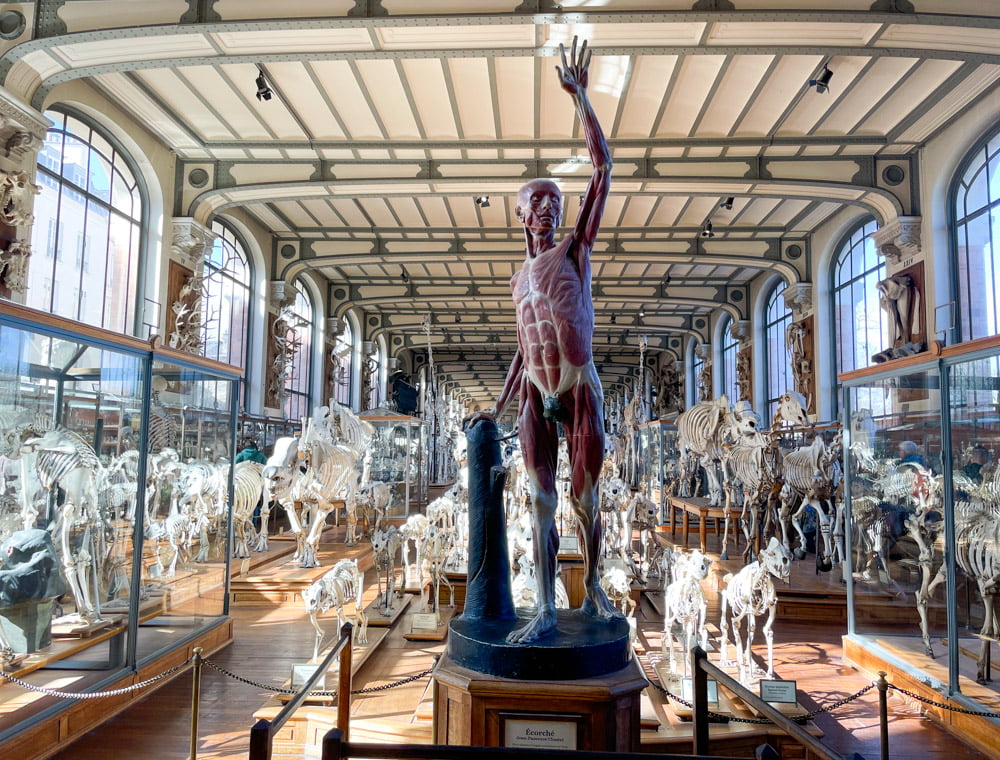
What to see in the Gallery of Palaeontology and Comparative Anatomy in Paris
The Galerie de Paléontologie et d’Anatomie Comparée building in Paris came from a collaboration between palaeontology professor Albert Gaudry, comparative anatomy professor Georges Pouchet and architect Ferdinand Dutert. I also recommend visiting this museum for its unique architecture. The structure is 80 metres long and features a glass ceiling and large windows to create a light-filled environment, with interiors decorated with parquet floors and Art Nouveau motifs inspired by nature.
Must-see animal skeletons: dinosaurs and cetaceans
The museum houses an extensive collection of animal skeletons, extinct or still in the wild. The largest skeletons are displayed in a single row in the central aisle. The experience is unique as it takes you through several million years of evolution as you pass through the Palaeontology and Comparative Anatomy Gallery.
Among the most famous dinosaur specimens is Diplodocus Carnegie, one of the largest dinosaurs ever. As for living animals, you can see a giraffe, which stands out due to its remarkable height, and cetaceans with baleen teeth, which arouse great curiosity in visitors, both adults and children.
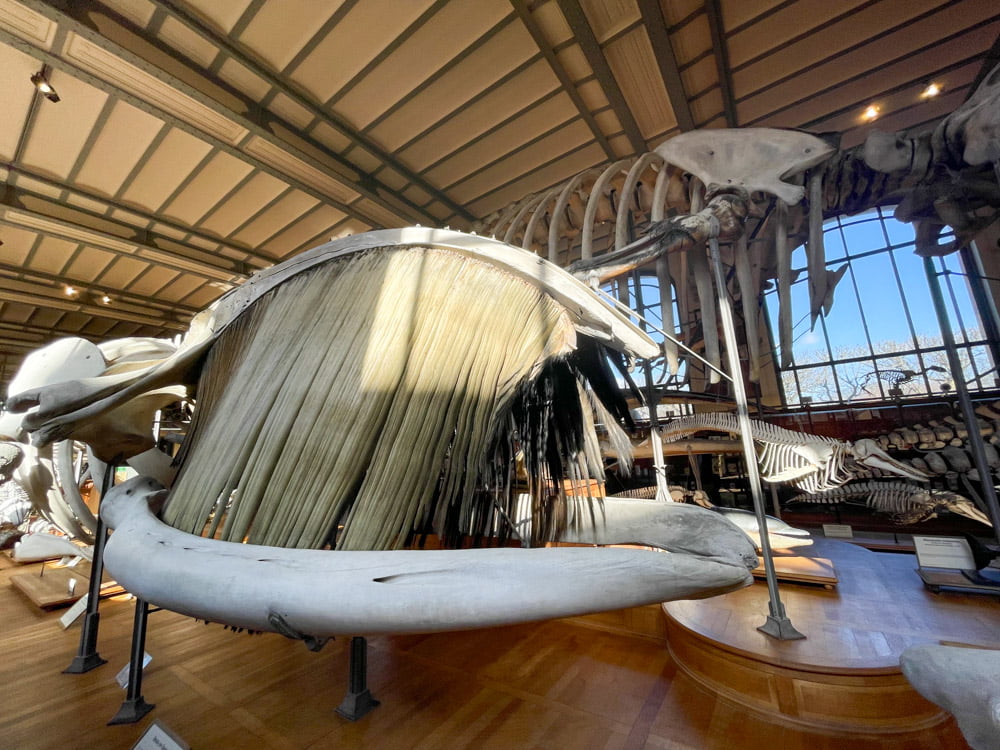
Smaller skeletons, fossils and invertebrates
Upper-floor balconies display an extensive collection of fossils and skeletons of smaller vertebrate and invertebrate animals. The comparative anatomy section offers a valuable opportunity to understand the similarities and differences between species and the variations within species.
The comparative anatomy collection includes a wide range of subjects, including skeletons of elephants, whales, monkeys and other creatures, as well as anatomical preparations showing in detail how organs function. Animal models with exposed entrails are usually a big hit with children. My son enjoyed them a lot, asking numerous questions about muscles, skeletons and organs.
Some foetuses and malformations are also on display in the museum under formalin. If they impress you, as they do me, you can avoid them because they are discreetly in a corner. However, these specimens are frequently displayed in natural science museums. They provide researchers with important information about the biology, anatomy and pathology of animals, as well as the evolution of species.
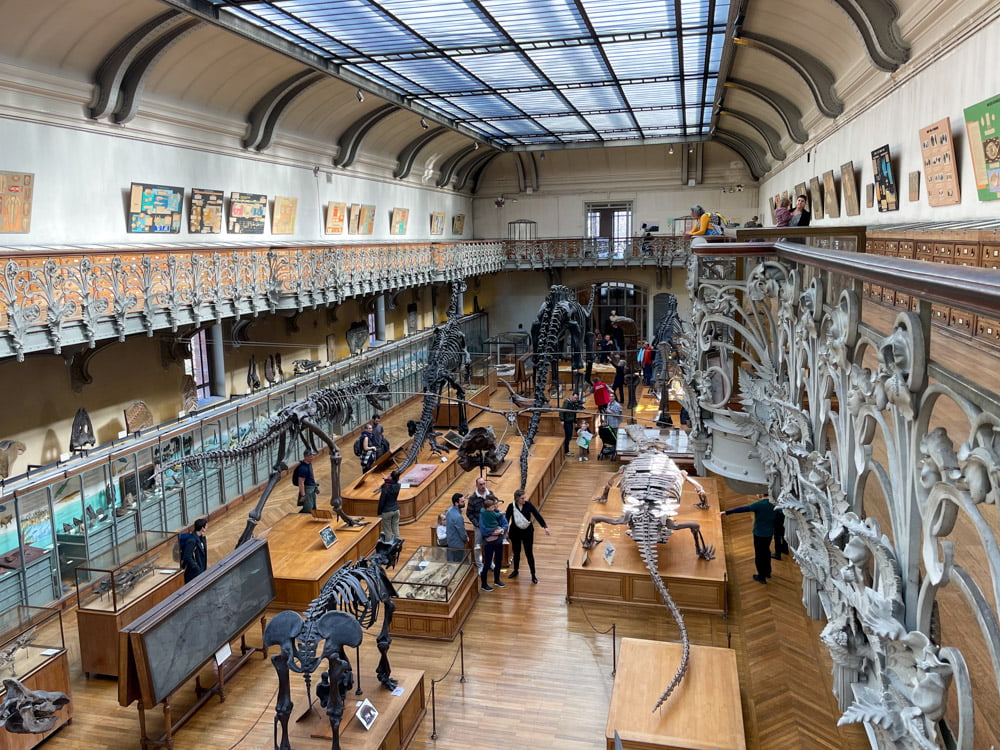
The restoration of the skeletons on display in the Gallery of Palaeontology and Comparative Anatomy in Paris
During our visit to the Galerie de Paléontologie et d’Anatomie Comparée in Paris, we noticed that Dufort’s Mammoth was under restoration. Although it was absent, we learned about the importance of restoring the animal skeletons on display and how the mounting and display of animals have evolved over time.
Bones are prone to damage due to temperature, humidity, and brightness, which can make them fragile and lead to their pulverisation, as in the mammoth case. Restoration involves removing previous plates and inserts, cleaning the bones, and reassembling the skeletons more naturally.
Over the years, the way animal skeletons are displayed has changed due to new discoveries by palaeontologists. Nowadays, the posture is decided based on a 3D model, and the assembly is done by reusing the previous metal structure wherever possible. The restoration process not only helps preserve the skeletons on display but also allows visitors to make new discoveries about prehistoric life.
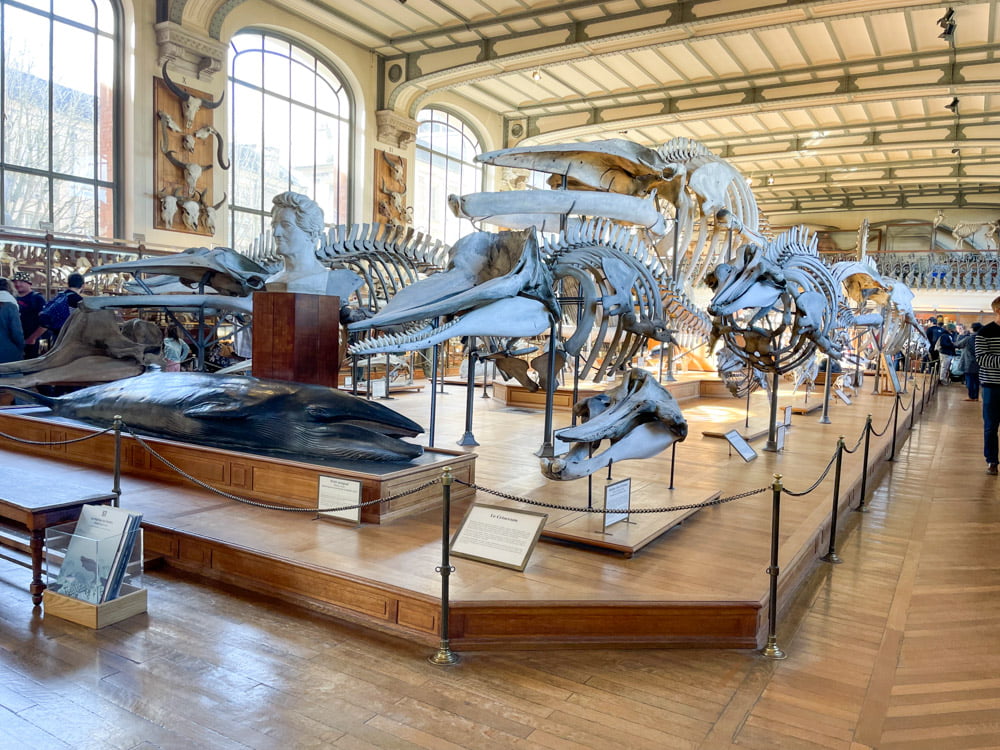
Gallery of Palaeontology and Comparative Anatomy in Paris with children: YES or NO
The Gallery of Palaeontology and Comparative Anatomy in Paris is an exciting place to visit with children. The collection of dinosaurs and other prehistoric animal skeletons is one of the gallery’s highlights. Still, there are also sections on invertebrates and marine animals.
The exhibits are impressive and make the visit enjoyable for all ages. Also, if your children speak French, they can participate in the educational activities organised by the Galerie de Paléontologie et d’Anatomie Comparée in Paris.
The Galerie de Paléontologie et d’Anatomie Comparée in Paris is perfect for stimulating children’s curiosity about the natural world and science in general. My son asked many questions about animal bodies, and the visit was very satisfying for both of us.
However, if your child is in a period of big existential questions or is an empathetic child, seeing the vast amount of skeletons might produce several uncomfortable questions that are difficult to answer. As always, when travelling as a family, consider visiting a museum according to the interests and sensitivities of your little ones.
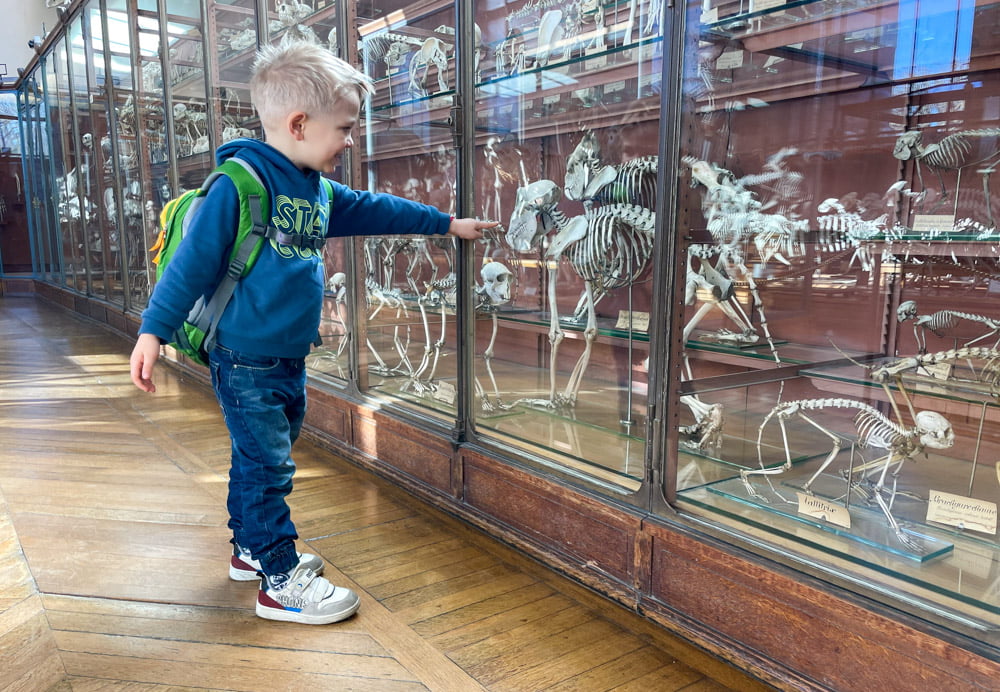
Practical information for visiting the Galerie de Paléontologie et d’Anatomie Comparée in Paris
The Galerie de Paléontologie et d’Anatomie Comparée in Paris is a curious and interesting museum for every nature and science lover. Located in the centre of Paris, it is very convenient to reach by public transport. However, being a 19th-century building, it is not fully accessible. Wheelchair users cannot access the upper rooms. If you are travelling with small children, it is undoubtedly more comfortable to travel with a baby carrier instead of a pushchair.
The Galerie de Paléontologie et d’Anatomie Comparée is open every day except Tuesdays, from 10 am to 6 pm, with the last admission one hour before closing. The hours are the same as the other Muséum National d’Histoire Naturelle sites. At the time of writing, there is no cumulative ticket. The nearby Great Gallery of Evolution, often visited together, has a separate entrance and ticket.
How much Galerie de Paléontologie et d’Anatomie Comparée tickets cost
Tickets to the Galerie de Paléontologie et d’Anatomie Comparée cost €10 for adults and €7 for concessions. Reductions are available for specific categories of visitors and for those who have purchased a full-price ticket for another Muséum National d’Histoire Naturelle site within the Jardin des Plantes or the Parc Zoologique de Paris within three months of their visit.
How to get to the Palaeontology and Comparative Anatomy Gallery
The Gallery of Palaeontology and Comparative Anatomy is located in the Jardin des Plantes, in the 5th arrondissement of Paris. The best way to get there is by public transport, with metro, RER, or bus stops around the Gare d’Austerlitz. Check the most convenient and fastest route using Google Maps, which works well in Paris.
Galerie de Paléontologie et d’Anatomie Comparée
2 Rue Buffon
75005 Paris
Where to stay in Paris
Sleeping in Paris can be expensive, prompting you to consider staying outside the city centre. In such a case, before selecting a hotel, I suggest you read my article on the best and worst neighbourhoods to stay in Paris.
I’ve visited Paris on several occasions for leisure and work, and I recommend a few places I’m familiar with. If you’re looking for a unique stay, Hôtel de Joséphine Bonaparte, built inside a 17th-century convent and located in the Marais district, is an excellent choice.
To save money, opt for the more affordable Hotel Bloum, situated close to the Opera and decorated with customised furnishings. Alternatively, the Aparthotel Adagio Paris Montmartre offers contemporary, self-catering apartments, perfect for families looking for more space in their rooms.
The Galerie de Paléontologie et d’Anatomie Comparée in Paris is a perfect stop if you’re looking for a curious museum to see with children. The vast collection of animal skeletons, fossils and other natural wonders worldwide is ideal for stimulating children’s curiosity and learning something new.
